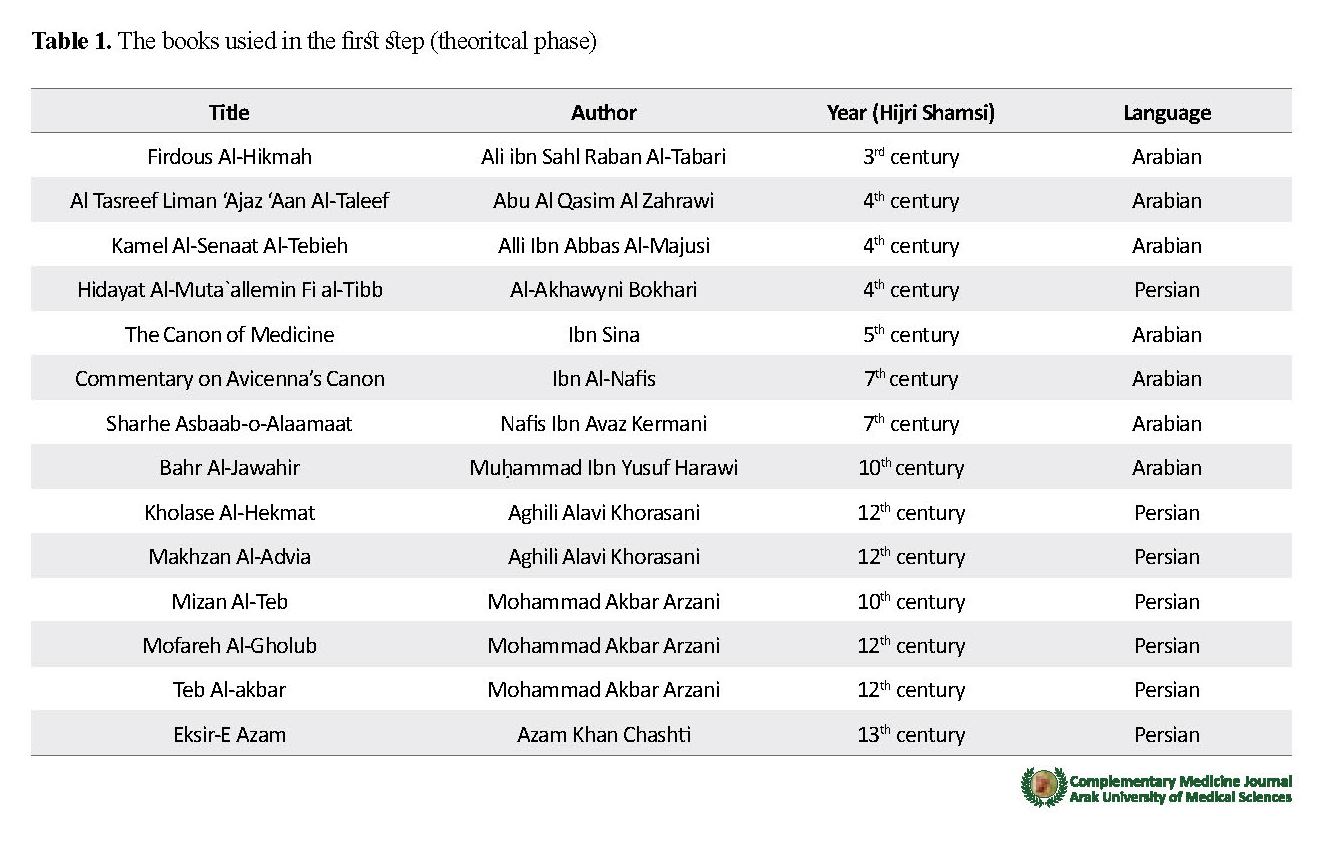Extended Abstract
1. Introduction
Thirst (Attash in Persian) stimulates the drinking behavior [1], regulates body fluids and is an annoying symptom [2, 3] in patients with chronic heart failure [4], admitted to the intensive care unit [5], chronic obstructive pulmonary disease [6], dialysis [7], diabetes [8] and schizophrenia [9]. In Iranian tradutional medicine (ITM), the symptoms of the disease are described based on observation [10, 11]. In conventional medicine, The Rome criteria are one of the most successful methods of using symptoms to diagnose diseases [12].
The low agreement between ITM specialists in the diagnosis of temperament (Mizaj) and dystemperament (Sue-mizaj) [13] shows the need to provide the same practical definitions for concepts such as signs and symptoms. Due to the importance of the symptoms of thirst in ITM and diagnosis of diseases expecially dystemperament, this study used the method of concept analysis to provide a clear and usable definition [14]for the concept of thirst [15].
2. Materials and Methods
A qualitative study of concept analysis was designed using a hybrid method consisting of three steps [16]. At the first phase (theoritical phase), after searching in the Noor library, keywords related to thirst and books with the most relevant content were selected based on the importance and credibility of the book and its author as well as the relevence of its texts. After dividing the texts into semantic units, the overt and covert concepts were identified. The search continued until information saturation was reached. The purpose of second step (fieldwork phase) was to investigate the new characteristics of thirst or Attash based on the clinical experiences of specialists and clarifying the characteristics mentioned in the texts by the interview method.
In this regard, interview questions were designed based on the results of previous step. ITM specialists were selected by usinga a purposive sampling method [17] with maximum diversity. In-depth, semi-structured, and face-to-face interviews continued until information saturation was achieved [18]. To achieve the main themes, after recording and typing the interviews and dividing the interviews into semantic units, coding was done with MAXQAD10 software [19]. At the final step (analytical phase), by comparing the findings of first step and working on determining the differences and similarities, a practical definition of thirst was presented from the combination of the findings of the two previous steps.
3. Results
In ITM, thirst is defined as the need for water and any food that is cold and wet [20, 21]; its moderate level is considered normal but its decrease and increase is a sign of illness [22]. False thirst is exacerbated by cold water and relieved by hot water, and tolerating thirst and sleeping reduces false thirst [22-29]. The time to quench your thirst after drinking water and the temperature and amonut of the water are used to determine the cause of thirst. Increased thirst is a symptom of hot mizaj and dominance of yellow bile (safra) and its decrease is a symptom of cold mizaj and dominance of phlegm [30, 31]. On the other hand, the causes of true thirst are: the need of the organs and the body for moisture, the need to eliminate dryness and abnormal heat, and the dilution of the eaten food [26].

Abnormal thirst is caused by the accumulation of concentrated salty sputum in the stomach, nature’s desire to eliminate and wash it [32], factors that prevent the absorption of water into the liver, reduction of main moisture [30] and the warmth of the mouth [32]. Thirst for each body organ has different characteristics [30, 33-35]. After interviewing 16 ITM specialists for 41 hours, the criteria for diagnosing thirst were reported: the amount of cousumed water and fluids, and change in tendency towards drinking water. Consumption of water based on habit and advice, suppression of thirst and drinking fluids to help relieve dry mouth were determined as the differential diagnosis of increased and decreased thirst. In the final analysis stage, a functional definition of thirst was obtained.

4. Discussion
In Iranian medical books, thirst is defined as the need for a cold and wet substance [21]; a strong desire for food of this quality is also considered as thirst [34]. In conventional medicine, thirst is a feeling that prioritizes receiving water [36, 37]. The degree of thirst from the perspective of ITM depends on the individual’s temperament, in addition to other individual and environmental factors [38]. Thirst and its decrease have been mentioned in most ITM books in the section related to diseases and symptoms of dystemperament, but in the section related to the symptoms of healthy temperament; sometimes the increase and decrease in thirst degree has been used to diagnose the dominant humor in a disease [30]. According to Hakim Jorjani, the causes of thirst are divided into two groups: bodily and non-bodily; bodily causes are divided into two groups: dystemperament and swelling/obstruction [39, 40].
Some scholars of ITM consider the “false thirst” as being thirsty due to the presence of a sticky sputum in the stomach, and the thirst due to the hot temperament of the stomach and liver and the thirst after eating the food is considered as “true thirst” [22]. Some Scholars belive that the thirst after eating, despite drinking enough water, is also a false thirst [28]. ITM specialists have also reported that the three factors recommended for the use of water by the Institute of Medicine (IOM) and the European Food Safety Authority (EFSA) are effective regardless of individual differences [41, 42], impaired thirst due to its suppression [43, 44] and dryness of the mouth [45] which must be distinguished from thirst and redcued thirst. The low number of studies on thirst and lack of access to some ITM specialists were some of the limitations of our study. It is recommended to investigate the prevalence of the symptom of increased and decreased thirst in patients and its relationship with the dominance of humors and dystemperament in future studies.
Ethical Considerations
Compliance with ethical guidelines
All ethical principles were considered in this article and this study has ethically approved (Code: IR.SBMU.RETECH.REC.1395.625). Participants were assured of the confidentiality of their information and were free to leave the study at any time.
Funding
The present paper was extracted from the PhD thesis of the first author, Department of Traditional Medicine, School of Traditional Medicine, Shahid Beheshti University of Medical Sciences.
Authors' contributions
Study Design, Conceptualization and Methodology: Morteza Mojahedi, Roshanak Mokaberinejad, Parisa Jafari ; Research, Original Writing: Parisa Jafari; Data Collection, Data Analysis and Interpretation: Parisa Jafari, Fatemeh Hakimi, Elham Parsa; Editing and Supervision: All authors.
Conflicts of interest
There is no conflict of interes in this sudy.
Acknowledgements
The authors would like to thank the Iranian Traditional Medicine specialists particpated in the study for their valuable cooperation.


 , Morteza Mojahedi2
, Morteza Mojahedi2 

 , Fatemeh Hakimi1
, Fatemeh Hakimi1 

 , Mojgan Tansaz1
, Mojgan Tansaz1 
 , Mina Movahhed1
, Mina Movahhed1 

 , Rasool Choopani1
, Rasool Choopani1 

 , Mahmood Khodadoost1
, Mahmood Khodadoost1 

 , Reza Ilkhani1
, Reza Ilkhani1 

 , Elham Parsa1
, Elham Parsa1 

 , Roshanak Mokaberinejad *3
, Roshanak Mokaberinejad *3 


